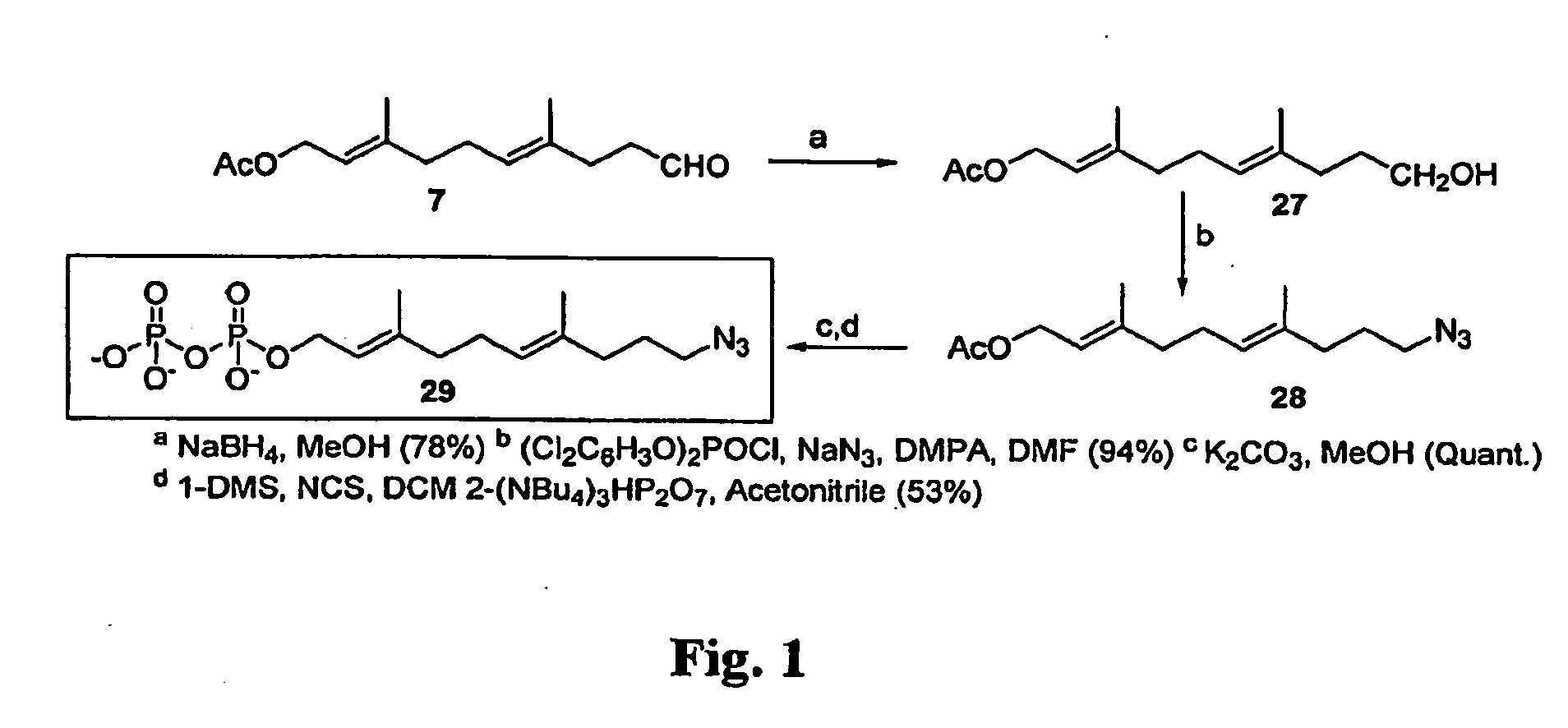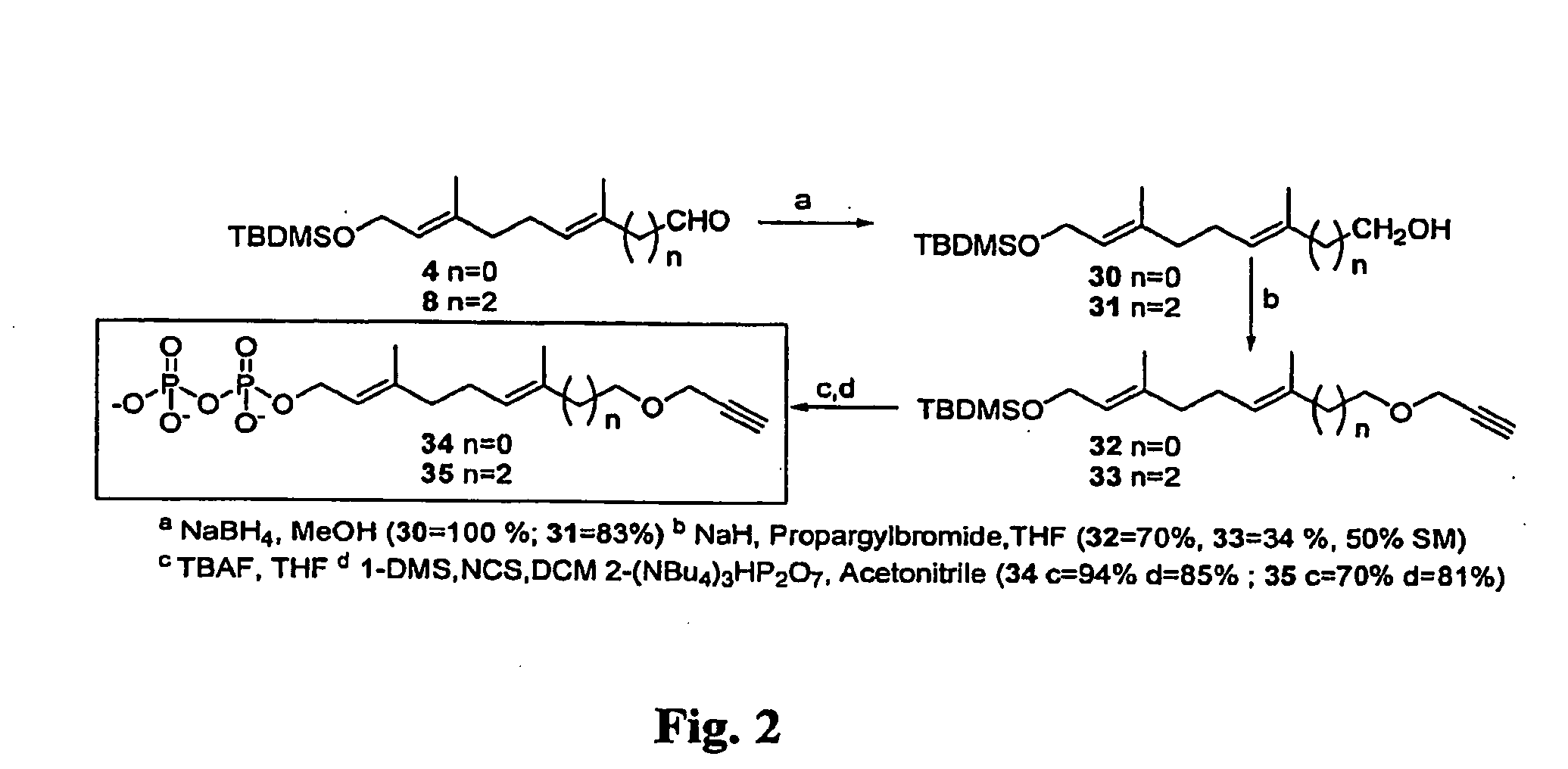Immobilized Proteins and Methods and Uses Thereof
a technology of immobilized proteins and proteins, applied in the field of covalent immobilization of proteins, can solve the problems of difficult to distinguish between nucleophiles on the protein and those in other biological molecules that may be present in a complex mixture, and it is difficult to target a specific site in a specific protein for covalent attachmen
- Summary
- Abstract
- Description
- Claims
- Application Information
AI Technical Summary
Benefits of technology
Problems solved by technology
Method used
Image
Examples
example 1
Preparation of Modified Green Fluorescent Protein (GFP) with a PFTase Recognition Site
[0042]The gene for the GFPuv protein was subcloned into a pQE-30Xa expression vector in order to append a His6 sequence to the N-terminus and the C-terminal RTRCVIA PFTase recognition site. A 714 bp fragment from pGFPuv containing GFPuv was amplified by PCR. The forward primer contained 28 bases, 17 of which were complementary to the vector sequence upstream of the 5′ end, FP-GFP: 5′-CCGGTAGCATGCATGAGTAAAGGAGAAG-3′ (SEQ ID NO:1). The GFP start codon is indicated in bold, and a SphI site is underlined. The reverse primer contained 57 bases, 21 of which were complementary to the of the 3′ end of RP-GFP: 5′-GACGATAAGCTTTTAAGCAATAACGCACCTAGTTCGTTTGTAGAGCTCATCCA TGCC-3′ (SEQ ID NO:2). The primer contained a HindIII site (underlined), and a C-terminal yeast RTRCVIA farnesylation motif (bold). The PCR product was purified on a 1% agarose gel and extracted from the gel using the GFX™ PCR DNA Gel band purif...
example 2
Preparation of Modified Glutathione S-transferase (GST) Protein a With PFTase Recognition Site
[0044]The gene for the GST protein was subcloned into a pQE-30Xa in order to append an N-terminal His6 affinity tag and a C-terminal RTRCVIA PFTase recognition site to the enzyme. A 660 bp fragment from pET-42b containing GST was amplified by PCR. The forward primer contained 33 bases, 21 of which were complementary to the vector sequence upstream of the 5′GST. FP_GST: 5′-ATACATAAGCTTATGTCCCCTATACTAGGTTAT-3′ (SEQ ID NO:3). The GST start codon is indicated in bold, and a BamHI site is underlined. The reverse primer contained 51 bases, 15 of which were complementary to the 3′ end of GST RP-GST: 5′-TGAACCAAGCTTTTAGGCTATAACACAGCGCGTACGATCCGATTTTGGAGG-3′ (SEQ ID NO:4). A HindIII site (underlined) and the C-terminal yeast farnesylation site (bold-enconding RTRCVIA) were introduced. The PCR product was purified on a 1% agarose gel and extracted using the GFX™ DNA purification kit. The purified DNA...
example 3
Preparation of Farnesyl Analogs
[0046]The general synthesis scheme for the preparation of compound 10-Azido-Disphosphate (10 AZDPP) is set forth in FIG. 1.
[0047]The general synthesis scheme for the preparation of propargyl ether derivatives of farnesyl diphosphate is set forth in FIG. 2.
[0048]The general synthesis scheme for the preparation of benzylazide derivatives of farnesyl diphosphate is set forth in FIG. 10.
[0049]The general synthesis scheme for the preparation of prenyl azide derivatives of farnesyl diphosphate is set forth in FIG. 11.
[0050]The general synthesis scheme for the preparation of propargylamine derivatives of farnesyl diphosphate is set forth in FIG. 12.
[0051]The general synthesis scheme for the preparation of propalamide derivatives of farnesyl diphosphate is set forth in FIG. 13.
PUM
| Property | Measurement | Unit |
|---|---|---|
| Structure | aaaaa | aaaaa |
| Solubility (mass) | aaaaa | aaaaa |
Abstract
Description
Claims
Application Information
 Login to View More
Login to View More - R&D
- Intellectual Property
- Life Sciences
- Materials
- Tech Scout
- Unparalleled Data Quality
- Higher Quality Content
- 60% Fewer Hallucinations
Browse by: Latest US Patents, China's latest patents, Technical Efficacy Thesaurus, Application Domain, Technology Topic, Popular Technical Reports.
© 2025 PatSnap. All rights reserved.Legal|Privacy policy|Modern Slavery Act Transparency Statement|Sitemap|About US| Contact US: help@patsnap.com



